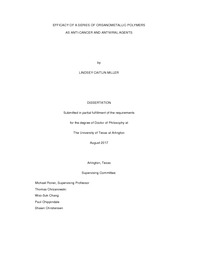
ATTENTION: The works hosted here are being migrated to a new repository that will consolidate resources, improve discoverability, and better show UTA's research impact on the global community. We will update authors as the migration progresses. Please see MavMatrix for more information.
Show simple item record
| dc.contributor.advisor | Roner, Michael | |
| dc.creator | Miller, Lindsey Caitlin | |
| dc.date.accessioned | 2017-10-02T14:38:55Z | |
| dc.date.available | 2017-10-02T14:38:55Z | |
| dc.date.created | 2017-08 | |
| dc.date.issued | 2017-08-18 | |
| dc.date.submitted | August 2017 | |
| dc.identifier.uri | http://hdl.handle.net/10106/26982 | |
| dc.description.abstract | Organometallic compounds, particularly organotin compounds, have been known to possess biological activity for over 80 years. A variety of these compounds have demonstrated antimicrobial, anti-cancer, and antiviral activities. With the discovery of the anti-cancer ability of cisplatin, the most widely used chemotherapeutic agent, the interest in the potential capabilities of metal-containing compounds increased substantially. Since then, several metal-containing compounds have been evaluated for their microbiological activity, and our laboratory focuses specifically on organometallic polymers. Our compounds are composed of a metal, especially tin, which acts as the Lewis acid, while the Lewis base in our compounds is provided by a variety of biologically active compounds. Through condensation reactions pioneered by Dr. Charles Carraher (Florida Atlantic University), we have been able to test a variety of organometallic compounds against an array of bacteria, cancer cell lines, and most recently, viruses. The present study summarizes the previous work demonstrating the anti-cancer ability of organometallic compounds, followed by the most recent studies involving the assessment of their antiviral activity. The viruses in this study include vaccinia virus, a double-stranded DNA virus, and Zika virus, a single stranded (+) RNA virus. In terms of anti-cancer ability, the polymers derived from group IV metallocenes show the most promise for future chemotherapeutic use. The polymers with the greatest potential for antiviral use against vaccinia virus are the group III compounds, which are compounds derived from various organotins and 3-amino-1,2-4 triazole. Three compounds have shown promise against Zika virus: compounds KB5, KB8, and FM1. The most promising group of polymers against two strains of Zika virus (501 and 502) are group II compounds, which are derived from various organotins and camphoric acid. | |
| dc.format.mimetype | application/pdf | |
| dc.language.iso | en_US | |
| dc.subject | Organotin compounds | |
| dc.subject | Viruses | |
| dc.subject | Cancer biology | |
| dc.subject | Organometallic compounds | |
| dc.subject | Antivirals | |
| dc.title | EFFICACY OF A SERIES OF ORGANOMETALLIC POLYMERS AS ANTI-CANCER AND ANTIVIRAL AGENTS | |
| dc.type | Thesis | |
| dc.degree.department | Biology | |
| dc.degree.name | Doctor of Philosophy in Quantative Biology | |
| dc.date.updated | 2017-10-02T14:39:26Z | |
| thesis.degree.department | Biology | |
| thesis.degree.grantor | The University of Texas at Arlington | |
| thesis.degree.level | Doctoral | |
| thesis.degree.name | Doctor of Philosophy in Quantative Biology | |
| dc.type.material | text | |
| dc.creator.orcid | 0000-0001-5438-5020 | |
Files in this item
- Name:
- MILLER-DISSERTATION-2017.pdf
- Size:
- 3.017Mb
- Format:
- PDF
This item appears in the following Collection(s)
Show simple item record


